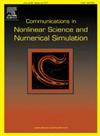顺月域不同模型间不变环面的统一转换方案
IF 3.8
2区 数学
Q1 MATHEMATICS, APPLIED
Communications in Nonlinear Science and Numerical Simulation
Pub Date : 2025-09-22
DOI:10.1016/j.cnsns.2025.109323
引用次数: 0
摘要
不变环面为检查地月动力学提供了基本基础,为长期基线解决方案提供了选择,并对全球相位空间有了更深入的了解。虽然利用不同保真度的模型来表征地月空间中的这些不变环面,但需要继续努力研究这些结构从低保真度模型到高保真度模型的演变。目前的研究重点是地月圆受限三体问题(CR3BP)及其在周期强迫模型(PFMs)和高保真星历模型(HFEM)中的类似物的周期轨道。特别是,这项工作利用了一个统一的数值框架,称为统一转换方案(UTS),以促进跨各种模型的模拟的数值构建。在UTS内,采用了具有连续方向灵活性的同伦策略。这种适应性为描述不同保真度模型的不变环面提供了可靠的方法,并解决了已知的挑战,例如,断裂分叉。包括L2光晕轨道分析在内的数值示例说明了所提出方法的有效性,并突出了其在推进地月任务设计和分析方面的潜力。本文章由计算机程序翻译,如有差异,请以英文原文为准。
Unified transition scheme for invariant tori across various models in the cislunar domain
The invariant tori supply a fundamental basis for examining cislunar dynamics, offering options for long-term baseline solutions and a deeper understanding of the global phase space. While models of varying fidelity are leveraged to characterize these invariant tori within cislunar space, continued efforts are required to investigate the evolution of these structures from lower-fidelity models to their higher-fidelity counterparts. The current investigation focuses on periodic orbits within the Earth-Moon Circular Restricted Three-Body Problem (CR3BP) and their analogs in Periodically Forced Models (PFMs) and the Higher-Fidelity Ephemeris Model (HFEM). In particular, this work leverages a unified numerical framework, termed the Unified Transition Scheme (UTS), to facilitate the numerical construction of the analogs across various models. Within the UTS, homotopy strategies with flexibilities in continuation directions are incorporated. This adaptability supplies reliable methods for characterizing invariant tori across models of evolving fidelity and addresses known challenges, e.g., broken bifurcations. Numerical examples, including the analysis of L halo orbits, illustrate the effectiveness of the proposed approach and highlight its potential to advance cislunar mission design and analysis.
求助全文
通过发布文献求助,成功后即可免费获取论文全文。
去求助
来源期刊

Communications in Nonlinear Science and Numerical Simulation
MATHEMATICS, APPLIED-MATHEMATICS, INTERDISCIPLINARY APPLICATIONS
CiteScore
6.80
自引率
7.70%
发文量
378
审稿时长
78 days
期刊介绍:
The journal publishes original research findings on experimental observation, mathematical modeling, theoretical analysis and numerical simulation, for more accurate description, better prediction or novel application, of nonlinear phenomena in science and engineering. It offers a venue for researchers to make rapid exchange of ideas and techniques in nonlinear science and complexity.
The submission of manuscripts with cross-disciplinary approaches in nonlinear science and complexity is particularly encouraged.
Topics of interest:
Nonlinear differential or delay equations, Lie group analysis and asymptotic methods, Discontinuous systems, Fractals, Fractional calculus and dynamics, Nonlinear effects in quantum mechanics, Nonlinear stochastic processes, Experimental nonlinear science, Time-series and signal analysis, Computational methods and simulations in nonlinear science and engineering, Control of dynamical systems, Synchronization, Lyapunov analysis, High-dimensional chaos and turbulence, Chaos in Hamiltonian systems, Integrable systems and solitons, Collective behavior in many-body systems, Biological physics and networks, Nonlinear mechanical systems, Complex systems and complexity.
No length limitation for contributions is set, but only concisely written manuscripts are published. Brief papers are published on the basis of Rapid Communications. Discussions of previously published papers are welcome.
 求助内容:
求助内容: 应助结果提醒方式:
应助结果提醒方式:


